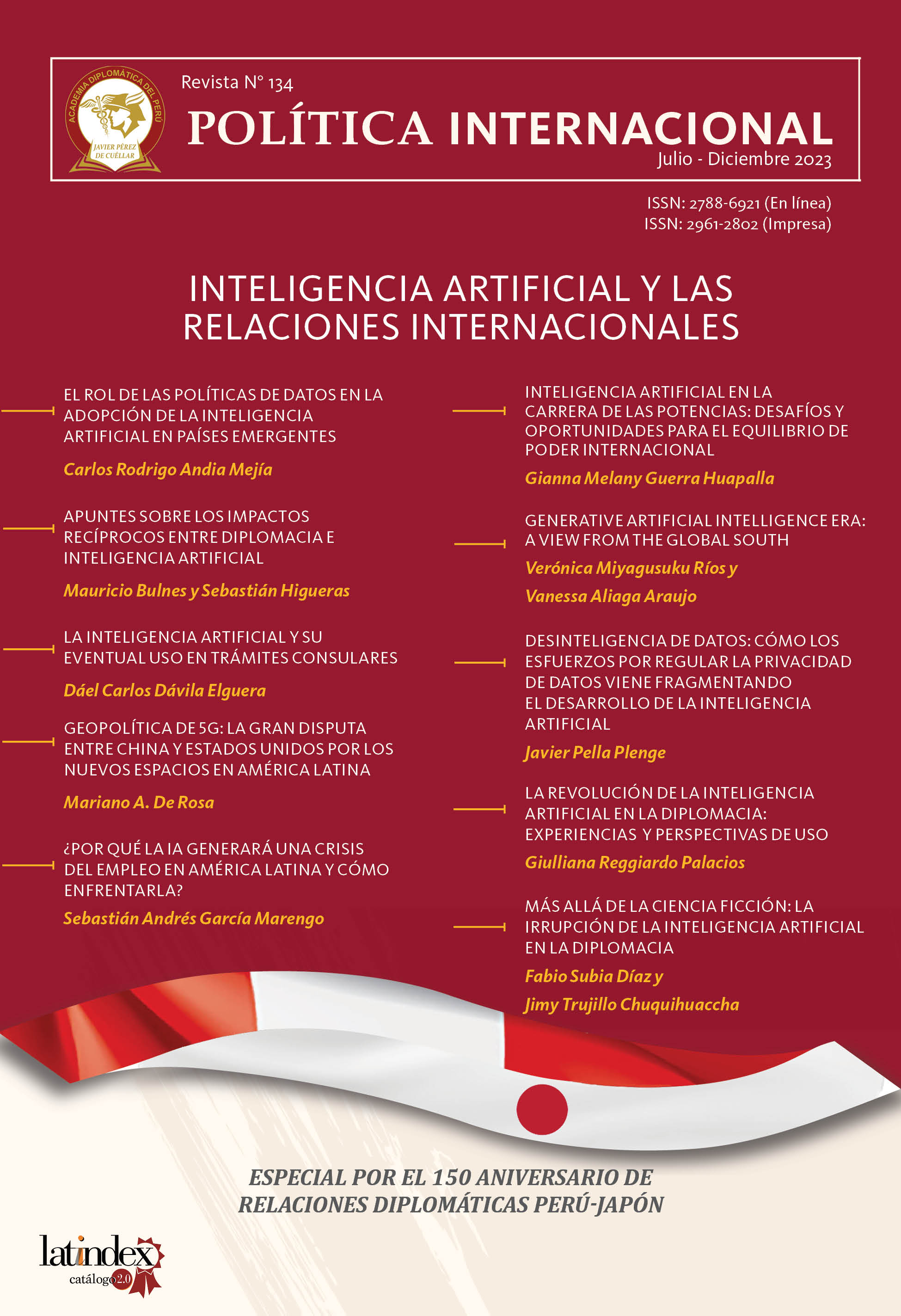Generative Artificial Intelligence Era: a view from the Global South
DOI:
https://doi.org/10.61249/pi.vi134.98Palabras clave:
Generative Artificial Intelligence, Artificial intelligence, regulation, Global South, multilateralism, diplomacy, PeruResumen
Generative Artificial Intelligence (GAI) is transforming societal structures; its hyper evolutionary nature and autonomous learning capabilities have put States in check, struggling to safeguard their interests and improve their positioning on the global power table. Given that this new technological wave has a global impact, it must also be regulated at a global level, which means that the multilateral system is the one to lead discussions in search of guidelines at the international level.
From a Global South perspective, the technical capabilities and financial resources to invest in GAI are very limited compared to more developed countries. This is why GAI innovations pose a risk of widening the existing gap between North and South. Unfortunately, although developing countries are the most vulnerable to the negative impacts of new technologies, their voices are precisely the least represented in global debates. Given this scenario, it is imperative that the Global South - and in particular, Peru - be present in the negotiations to mitigate GAI potential adverse effects.
Descargas
Bibliografía
Bremmer, I., & Suleyman, M. (2023, September 07). How AI Could Upend Geopolitics. A Conversation With Ian Bremmer and Mustafa Suleyman. (D. Kurtz-Phelan, Interviewer)
Bremmer, I., & Suleyman, M. (2023, August 16). The AI Power Paradox. Can States Learn to Govern Artificial Intelligence—Before It’s Too Late? Foreign Affairs, https://www.foreignaffairs.com/world/artificial-intelligence-power-paradox.
CEPLAN. (2021). Inteligencia artificial: desafíos y oportunidades para el Perú. Lima: Centro Nacional de Planeamiento Estratégico. Retrieved from https://www.gob.pe/institucion/ceplan/informes-publicaciones/2296616-inteligencia-artificial-desafios-y-oportunidades-para-el-peru
El Peruano. (2023). Clonación de voz: autoridad nacional brinda recomendaciones ante nueva modalidad de estafa. El Peruano, https://elperuano.pe/noticia/218424-clonacion-de-voz-autoridad-nacional-brinda-recomendaciones-ante-nueva-modalidad-de-estafa.
Fanni, R. (28 de junio de 2023). La UE debe abordar los riesgos que plantea la IA militar. Política Exterior.
García, E. V. (2020). Multilateralism and Artificial Intelligence: What Role for the United Nations? SSRN Paper, 1-20. Retrieved from https://ssrn.com/abstract=3779866
Global Times. ((July 6 2023). How US military, tech firms profit from Russia-Ukraine conflict by turning it into an ‘AI warfare’ testing ground. Global Times. Retrieved from https://www.globaltimes.cn/page/202307/1293883.shtml
GPT-3. (September 5 2023). AI assistant.
Hoschild, F. (December 2018). The Secretary-General’s Strategy on New Technologies. New Technologies: Where To?, p. Nos. 3 & 4 Vol. LV. Retrieved from https://www.un.org/en/un-chronicle/secretary-general%E2%80%99s-strategy-new-technologies-0
Hsu, T., & Lee Myers, S. (2023, June 25). A.I.’s Use in Elections Sets Off a Scramble for Guardrails. The New York Times, https://www.nytimes.com/2023/06/25/technology/ai-elections-disinformation-guardrails.html.
Human Rights Council. (2023). New and Emerging Digital Technologies and Human Rights. Resolution 53/29. Geneva: UN Human Rights Council.
OECD. (2019). Compendium of Legal Instruments of the OECD. Recommendation of the Council on Artificial Intelligence. Paris: OECD/LEGAL/0449. Retrieved from https://legalinstruments.oecd.org/en/instruments/OECD-LEGAL-0449
Oxford Insights. (2022). Government AI Readiness Index 2022. Malvern: Oxford Insights. Retrieved from https://www.oxfordinsights.com/government-ai-readiness-index-2022
Peruvian Government. (2021). Estrategia Nacional de Inteligencia Artificial. Lima: Presidencia del Consejo de Ministros - Gobierno del Perú. Retrieved from https://www.gob.pe/15762-estrategia-nacional-de-inteligencia-artificial-ia
Peruvian Government. (2023). Ley 31814. Ley que promueve el uso de la Inteligencia Artificial en favor del desarrollo económico y social del país. Lima: Diario Oficial El Peruano. Retrieved from https://busquedas.elperuano.pe/dispositivo/NL/2192926-1
Real Time Management Consulting & PAD - University of Piura. (2019). Estudio: Transformación Digital 2019. Lima: RTM & PAD. Retrieved from https://www.rtm.com.pe/td/transformacion-digital-2019/
Robins-Early, N. (2023, July 19). Disinformation reimagined: how AI could erode democracy in the 2024 US elections. The Guardian.
Shamoug, A. (2022, July 05). In Ukraine, machine-learning algorithms and big data scans used to identify war-damaged infrastructure. UNDP. Retrieved from https://www.undp.org/blog/ukraine-machine-learning-algorithms-and-big-data-scans-used-identify-war-damaged-infrastructure
Shapiro, J., & Cota, J. (2023). An Overview Of Global Ai Regulation And What’s Next . The Progressive Policy Institute. Retrieved from https://www.progressivepolicy.org/blogs/an-overview-and-of-global-ai-regulation-and-whats-next/
Standford University HAI. (2023). The AI Index 2023 Annual Report. California: Standford University - AI Index Steering Committee.
Tinnirello, M. (2022). The Global Politics of Artificial Intelligence. Florida: Chapman & Hall.
UNESCO. (2021). Recommendation on the Ethics of Artificial Intelligence. Paris. Retrieved from https://unesdoc.unesco.org/ark:/48223/pf0000381137
UNESCO. (2023). Safeguarding freedom of expression and access to information: guidelines for a multistakeholder approach in the context of regulating platforms. Paris: UNESCO.
WEF. (2023). Future of Jobs Report. Geneva: World Economic Forum. Retrieved from https://www.weforum.org/reports/the-future-of-jobs-report-2023/
WEF. (2023, April). World Economic Forum. Retrieved from AI Governance Alliance: https://initiatives.weforum.org/ai-governance-alliance/home
Descargas
Publicado
Cómo citar
Número
Sección
Licencia
Derechos de autor 2023 Vanessa Aliaga, Verónica Miyagusuku Ríos

Esta obra está bajo una licencia internacional Creative Commons Atribución 4.0.








